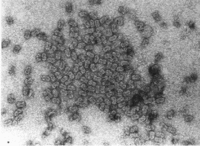Geminiviridae
A Viral Biorealm page on the family Geminiviridae

Baltimore Classification
Higher order taxa
Virus; ssDNA viruses; Geminiviridae
Genera
Mastrevirus, Begomovirus, Topocurvirus, Curtovirus
Description and Significance
Geminiviruses are DNA plant viruses transmitted by insects, particularly leafhoppers and whiteflies. The genera are distinguished by the type of plant they infect, the number of DNA segments, and the type of vector. Geminiviruses can wipe out entire crops of many different plants (such as tomatos, beans, corn, cassava, and cotton), making them a serious threat to farming industry worldwide. (source: Padidam et al., Rybicki)
Genome Structure
Geminiviruses have circular single-stranded DNA. The genome is either in two segments or not segmented at all. The non-segmented genome is 2500-3000 nucleotides long, and the segmented genome is 4800-5600 nucleotides long. The genome encodes for both structural and non-structural proteins. In geminiviruses with the segmented genome, both segments must be transmitted to the host for a full systemic infection to occur. (source: ICTVdB, Descriptions of Plant Viruses)
Virion Structure of a Geminivirus

Geminiviruses are non-enveloped, icosahedral virions that consist of a capsid. The capsid is geminate, or twinned, and consists of 22 capsomers. The capsid is 30 nm long and has a diameter of 18-20 nm. (source: ICTVdB)
Reproductive Cycle of a Geminivirus in a Host Cell
Geminivirus is transmitted to host plants by way of insects. Geminiviruses only encode for a few proteins, so it only supplies the DNA for viral replication and uses the host's DNA replication proteins to amplify its genome. The viral single-strand DNA is converted to double-strand DNA, which is then used to amplify viral double-strand DNA and replicate single-strand DNA genomes. Geminiviruses also control the host plant's cell cycle, allowing cells in which the virus has used up its DNA replicating capabilities to regain the ability to support high levels of (viral) DNA replication. (sources: The Hanley-Bowdoin Lab, Gutierrez)
Interestingly, geminiviruses are one of the few plant virus families which uses a DNA genome. According to Rojas et al., most plant viruses use an RNA genome, which suggests that plants have controlled the evolution of DNA viruses. Geminiviruses evolved the ability to control the cell cycle (which was mentioned previously), several strategies for cell-to-cell and long-distance movement, and ways to get around the host's antiviral systems as a response to the impediments to DNA viruses plants have created. Because of these abilities that geminiviruses have, they have become one of the most deadly plant pathogens in the world, causing devastating crop losses worldwide.
Viral Ecology & Pathology
Geminiviruses infect numerous different plants, and new strains emerge often, as the virus swaps genetic material with other strains. The spread of infection is limited to the ecosystems where the carrier insects live, which tend to be temperate climates that are also good for growing crops. (source: Moffat)
References. Updated June 5, 2006
Descriptions of Plant Viruses - Notes on Family: Geminiviridae
Gutierrez C. "Geminivirus DNA replication." Cell Mol Life Sci 56.3-4 (1999): 313-29.
The Hanley-Bowdoin Lab - Geminivirus - Host Interactions
ICTVdB - The Universal Virus Database, version 3. http://www.ncbi.nlm.nih.gov/ICTVdb/ICTVdB/
Padidam et al. "Possible Emergence of New Geminiviruses by Frequent Recombination." Virology 265.2 (1999): 218-225.
Moffat, Anne Simon. "Geminiviruses Emerge as Serious Crop Threat." Science 286 (1999): 1835.
Rybicki, Ed. The Maize Streak Virus Home Page - Geminiviridae
